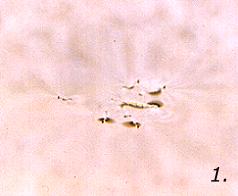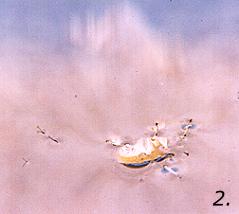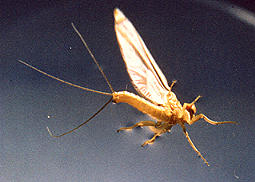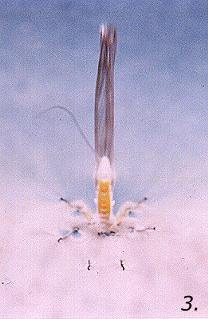Ephemerella dorothea
Don't let this turn you off! "Ephemerella dorothea." There, I said it and
I'm glad. It's time for you to expand your fly-tying world. Let's start now. There
seems to be a zillion, perhaps, two zillion tied flies, all of which will catch a trout
at some time or other. That is the magic of fly-fishing; and thus, fly-tying. Darn near
anything will at sometime or other, catch a trout.
This is not a bad thing; in fact, probably a very good situation. It allows even
the rank-amateur, beginner, novice, and the professional, nearly a level playing
field. You tie it, properly present it, and something will bite it. True with dry's,
nymphs, emergers, and many others as well.
Face it; spring brings the olive-drab Hendrickson's
( Ephemerella subvaria),
then the color shift is to yellow,
( Ephemerella dorothea ), and on into summer
and fall. Each season has it's own bugs. The trout eat them all. There are several
other insects along with these, but these are often found on most east and
mid-west streams from late May all the way to July.
Names vary by regions; sulphurs, yellow-sally's, pale evening duns, and more.
The flies tied are to represent the local variations of the mayflies on the stream
at any given time. So, just this once, lets try something a bit different.
Learn the name of the insect; and you create the fly.
Below are some pictures I took a while back of the insect as it looks to the
trout from below the surface (1.), as it nears the edge of the 'window'
(2.), what it looks like to the trout just as he takes it (3.), and (4.) what it really
looks like from directly below.
Using this information, go for it. By now you know how to put stuff on a hook;
well, use your talents. The insect does vary a bit by area and region, even on
the same stream. However, they will almost always be size 16 to 18. That gives
you about all you need to know. It was all I needed to tie a fly that did very
well a few years back, and you can too. *
Check you local streams. This fly is a dun (sub-imago). Start with that. Your
color may vary from yellow to a bit on the olive side, check it out. Am I going
to say you must tie it parachute, no-hackle, sparkle-schmarkle, or a Marinaro-thorax?
Not a chance. You are on your own. Let's see just how good you are. Fast water?
Dead calm pond? Tail of a run? Could make a difference as to how you tie it, right?
Often they are a bit messy when hatching, struggling with their nymphal shuck. They
may float a good distance trying to get rid of it, or if the evening is hot and dry, pop
right of the surface. Fun stuff.
Oh yes, the spinner fall (imago)? It can be a dandy; it often happens shortly after
the hatch.
*(hint) I did use dilute sulphuric acid to dye some rabbit fur to the shade
of yellow I wanted for the body part.


|





